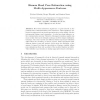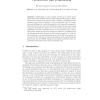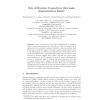KI
2010
Springer
13 years 10 months ago
2010
Springer
Non-verbal interaction signals are of great interest in the research field of natural human-robot interaction. These signals are not limited to gestures and emotional expressions ...
KI
2010
Springer
13 years 10 months ago
2010
Springer
Abstract. In mobile and ubiquitous computing, there is a strong need for supporting different users with different interests, needs, and demands. Activity recognition systems for c...
KI
2010
Springer
13 years 10 months ago
2010
Springer
KI
2010
Springer
13 years 10 months ago
2010
Springer
Abstract. Unlike people, household robots cannot rely on commonsense knowledge when accomplishing everyday tasks. We believe that this is one of the reasons why they perform poorly...
KI
2010
Springer
13 years 10 months ago
2010
Springer
The key task in probabilistic reasoning is to appropriately update one’s beliefs as one obtains new information in the form of evidence. In many application settings, however, th...
KI
2010
Springer
13 years 10 months ago
2010
Springer
Most approaches to the visual perception of humans do not include high-level activity recognitition. This paper presents a system that fuses and interprets the outputs of several c...
KI
2010
Springer
13 years 10 months ago
2010
Springer
Abstract. In the DESIRE project an autonomous robot capable of performing service tasks in a typical kitchen environment has been developed. The overall system consists of various ...
JELIA
2010
Springer
13 years 10 months ago
2010
Springer
Stable belief sets were introduced by R. Stalnaker in the early ’80s, as a formal representation of the epistemic state for an ideal introspective agent. This notion motivated M...
JELIA
2010
Springer
13 years 10 months ago
2010
Springer
Traditionally, a logic program is built up to reason about atomic first-order formulas. The key idea of parametrized logic programming is that, instead of atomic first-order form...
JELIA
2010
Springer
13 years 10 months ago
2010
Springer
Abstract. Many proposals for logic-based formalizations of argumentation consider an argument as a pair (Φ, α), where the support Φ is understood as a minimal consistent subset ...




